Guan Wang
State Key Laboratory of Precision Measurement Technology and Instruments, Department of Precision Instrument, Tsinghua University, Beijing, China, Key Laboratory of Photonic Control Technology
TRKT: Weakly Supervised Dynamic Scene Graph Generation with Temporal-enhanced Relation-aware Knowledge Transferring
Aug 07, 2025Abstract:Dynamic Scene Graph Generation (DSGG) aims to create a scene graph for each video frame by detecting objects and predicting their relationships. Weakly Supervised DSGG (WS-DSGG) reduces annotation workload by using an unlocalized scene graph from a single frame per video for training. Existing WS-DSGG methods depend on an off-the-shelf external object detector to generate pseudo labels for subsequent DSGG training. However, detectors trained on static, object-centric images struggle in dynamic, relation-aware scenarios required for DSGG, leading to inaccurate localization and low-confidence proposals. To address the challenges posed by external object detectors in WS-DSGG, we propose a Temporal-enhanced Relation-aware Knowledge Transferring (TRKT) method, which leverages knowledge to enhance detection in relation-aware dynamic scenarios. TRKT is built on two key components:(1)Relation-aware knowledge mining: we first employ object and relation class decoders that generate category-specific attention maps to highlight both object regions and interactive areas. Then we propose an Inter-frame Attention Augmentation strategy that exploits optical flow for neighboring frames to enhance the attention maps, making them motion-aware and robust to motion blur. This step yields relation- and motion-aware knowledge mining for WS-DSGG. (2) we introduce a Dual-stream Fusion Module that integrates category-specific attention maps into external detections to refine object localization and boost confidence scores for object proposals. Extensive experiments demonstrate that TRKT achieves state-of-the-art performance on Action Genome dataset. Our code is avaliable at https://github.com/XZPKU/TRKT.git.
GBGC: Efficient and Adaptive Graph Coarsening via Granular-ball Computing
Jun 24, 2025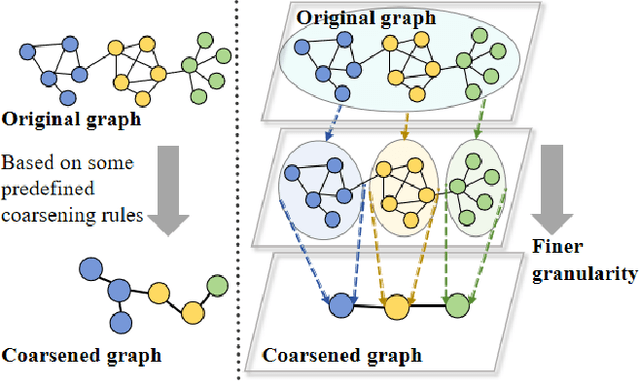
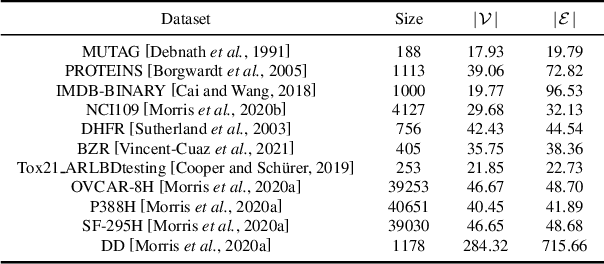
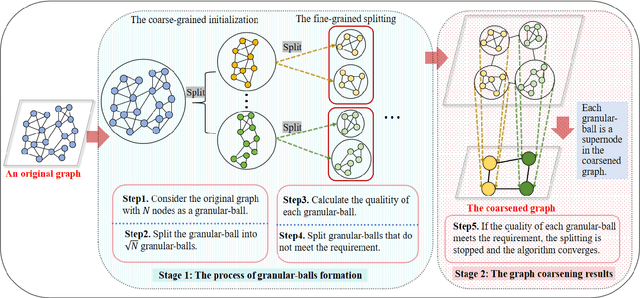

Abstract:The objective of graph coarsening is to generate smaller, more manageable graphs while preserving key information of the original graph. Previous work were mainly based on the perspective of spectrum-preserving, using some predefined coarsening rules to make the eigenvalues of the Laplacian matrix of the original graph and the coarsened graph match as much as possible. However, they largely overlooked the fact that the original graph is composed of subregions at different levels of granularity, where highly connected and similar nodes should be more inclined to be aggregated together as nodes in the coarsened graph. By combining the multi-granularity characteristics of the graph structure, we can generate coarsened graph at the optimal granularity. To this end, inspired by the application of granular-ball computing in multi-granularity, we propose a new multi-granularity, efficient, and adaptive coarsening method via granular-ball (GBGC), which significantly improves the coarsening results and efficiency. Specifically, GBGC introduces an adaptive granular-ball graph refinement mechanism, which adaptively splits the original graph from coarse to fine into granular-balls of different sizes and optimal granularity, and constructs the coarsened graph using these granular-balls as supernodes. In addition, compared with other state-of-the-art graph coarsening methods, the processing speed of this method can be increased by tens to hundreds of times and has lower time complexity. The accuracy of GBGC is almost always higher than that of the original graph due to the good robustness and generalization of the granular-ball computing, so it has the potential to become a standard graph data preprocessing method.
Transferable Mask Transformer: Cross-domain Semantic Segmentation with Region-adaptive Transferability Estimation
Apr 08, 2025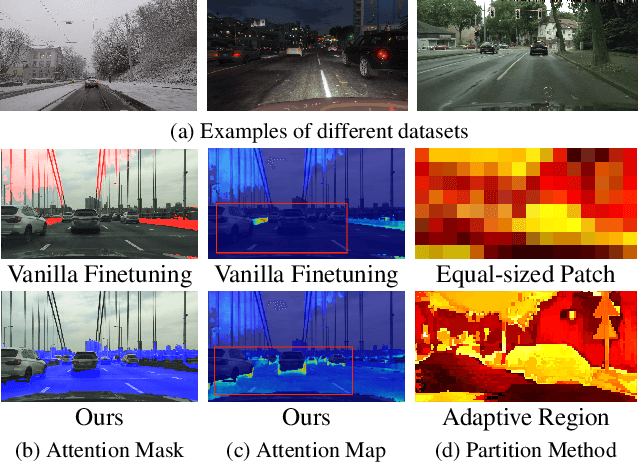
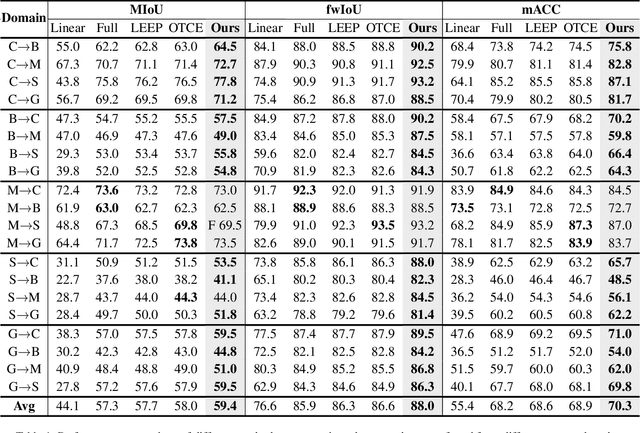
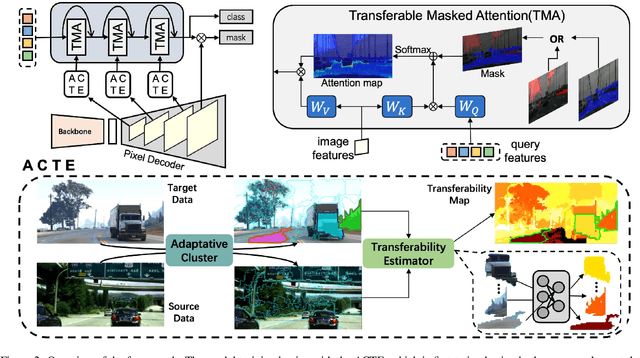

Abstract:Recent advances in Vision Transformers (ViTs) have set new benchmarks in semantic segmentation. However, when adapting pretrained ViTs to new target domains, significant performance degradation often occurs due to distribution shifts, resulting in suboptimal global attention. Since self-attention mechanisms are inherently data-driven, they may fail to effectively attend to key objects when source and target domains exhibit differences in texture, scale, or object co-occurrence patterns. While global and patch-level domain adaptation methods provide partial solutions, region-level adaptation with dynamically shaped regions is crucial due to spatial heterogeneity in transferability across different image areas. We present Transferable Mask Transformer (TMT), a novel region-level adaptation framework for semantic segmentation that aligns cross-domain representations through spatial transferability analysis. TMT consists of two key components: (1) An Adaptive Cluster-based Transferability Estimator (ACTE) that dynamically segments images into structurally and semantically coherent regions for localized transferability assessment, and (2) A Transferable Masked Attention (TMA) module that integrates region-specific transferability maps into ViTs' attention mechanisms, prioritizing adaptation in regions with low transferability and high semantic uncertainty. Comprehensive evaluations across 20 cross-domain pairs demonstrate TMT's superiority, achieving an average 2% MIoU improvement over vanilla fine-tuning and a 1.28% increase compared to state-of-the-art baselines. The source code will be publicly available.
Are Expressive Models Truly Necessary for Offline RL?
Dec 15, 2024



Abstract:Among various branches of offline reinforcement learning (RL) methods, goal-conditioned supervised learning (GCSL) has gained increasing popularity as it formulates the offline RL problem as a sequential modeling task, therefore bypassing the notoriously difficult credit assignment challenge of value learning in conventional RL paradigm. Sequential modeling, however, requires capturing accurate dynamics across long horizons in trajectory data to ensure reasonable policy performance. To meet this requirement, leveraging large, expressive models has become a popular choice in recent literature, which, however, comes at the cost of significantly increased computation and inference latency. Contradictory yet promising, we reveal that lightweight models as simple as shallow 2-layer MLPs, can also enjoy accurate dynamics consistency and significantly reduced sequential modeling errors against large expressive models by adopting a simple recursive planning scheme: recursively planning coarse-grained future sub-goals based on current and target information, and then executes the action with a goal-conditioned policy learned from data rela-beled with these sub-goal ground truths. We term our method Recursive Skip-Step Planning (RSP). Simple yet effective, RSP enjoys great efficiency improvements thanks to its lightweight structure, and substantially outperforms existing methods, reaching new SOTA performances on the D4RL benchmark, especially in multi-stage long-horizon tasks.
A Riemannian Approach for Spatiotemporal Analysis and Generation of 4D Tree-shaped Structures
Aug 22, 2024



Abstract:We propose the first comprehensive approach for modeling and analyzing the spatiotemporal shape variability in tree-like 4D objects, i.e., 3D objects whose shapes bend, stretch, and change in their branching structure over time as they deform, grow, and interact with their environment. Our key contribution is the representation of tree-like 3D shapes using Square Root Velocity Function Trees (SRVFT). By solving the spatial registration in the SRVFT space, which is equipped with an L2 metric, 4D tree-shaped structures become time-parameterized trajectories in this space. This reduces the problem of modeling and analyzing 4D tree-like shapes to that of modeling and analyzing elastic trajectories in the SRVFT space, where elasticity refers to time warping. In this paper, we propose a novel mathematical representation of the shape space of such trajectories, a Riemannian metric on that space, and computational tools for fast and accurate spatiotemporal registration and geodesics computation between 4D tree-shaped structures. Leveraging these building blocks, we develop a full framework for modelling the spatiotemporal variability using statistical models and generating novel 4D tree-like structures from a set of exemplars. We demonstrate and validate the proposed framework using real 4D plant data.
Crafting Efficient Fine-Tuning Strategies for Large Language Models
Jul 18, 2024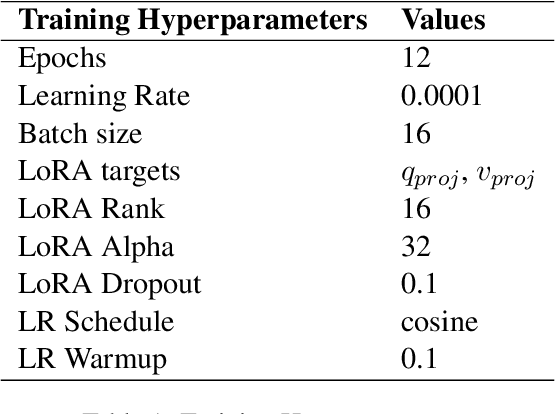
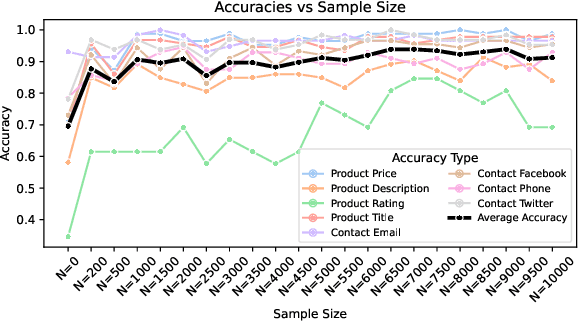
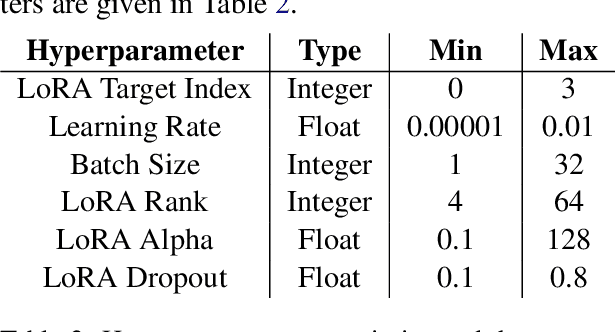
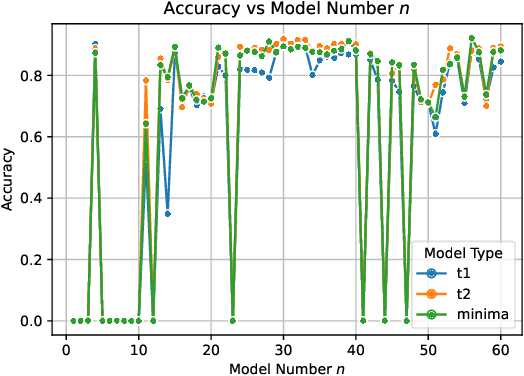
Abstract:This paper addresses the challenges of efficiently fine-tuning large language models (LLMs) by exploring data efficiency and hyperparameter optimization. We investigate the minimum data required for effective fine-tuning and propose a novel hyperparameter optimization method that leverages early-stage model performance. Our experiments demonstrate that fine-tuning with as few as 200 samples can improve model accuracy from 70\% to 88\% in a product attribute extraction task. We identify a saturation point of approximately 6,500 samples, beyond which additional data yields diminishing returns. Our proposed bayesian hyperparameter optimization method, which evaluates models at 20\% of total training time, correlates strongly with final model performance, with 4 out of 5 top early-stage models remaining in the top 5 at completion. This approach led to a 2\% improvement in accuracy over baseline models when evaluated on an independent test set. These findings offer actionable insights for practitioners, potentially reducing computational load and dependency on extensive datasets while enhancing overall performance of fine-tuned LLMs.
OED: Towards One-stage End-to-End Dynamic Scene Graph Generation
May 27, 2024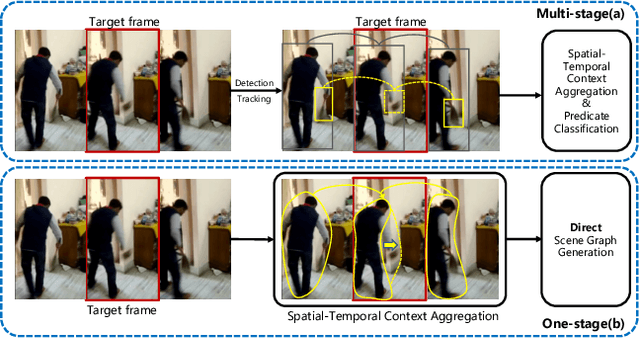
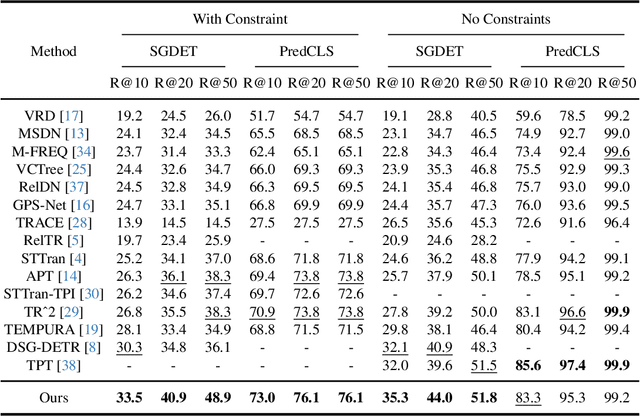
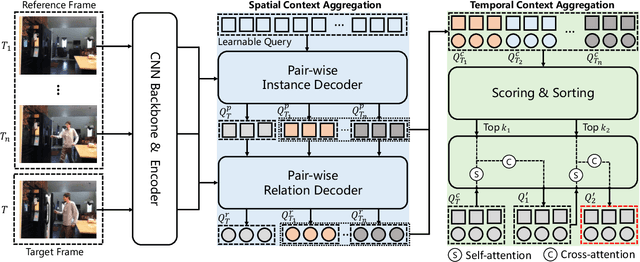
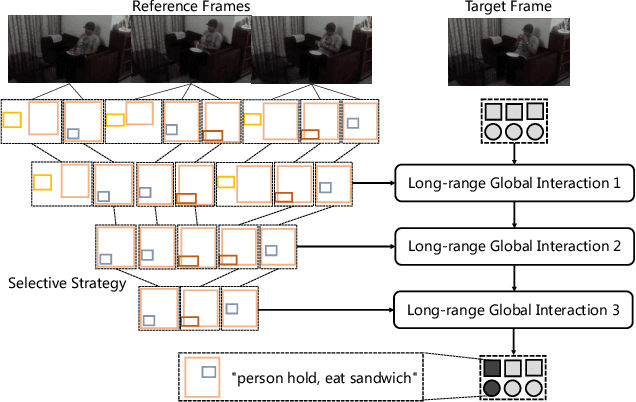
Abstract:Dynamic Scene Graph Generation (DSGG) focuses on identifying visual relationships within the spatial-temporal domain of videos. Conventional approaches often employ multi-stage pipelines, which typically consist of object detection, temporal association, and multi-relation classification. However, these methods exhibit inherent limitations due to the separation of multiple stages, and independent optimization of these sub-problems may yield sub-optimal solutions. To remedy these limitations, we propose a one-stage end-to-end framework, termed OED, which streamlines the DSGG pipeline. This framework reformulates the task as a set prediction problem and leverages pair-wise features to represent each subject-object pair within the scene graph. Moreover, another challenge of DSGG is capturing temporal dependencies, we introduce a Progressively Refined Module (PRM) for aggregating temporal context without the constraints of additional trackers or handcrafted trajectories, enabling end-to-end optimization of the network. Extensive experiments conducted on the Action Genome benchmark demonstrate the effectiveness of our design. The code and models are available at \url{https://github.com/guanw-pku/OED}.
CT Synthesis with Conditional Diffusion Models for Abdominal Lymph Node Segmentation
Mar 26, 2024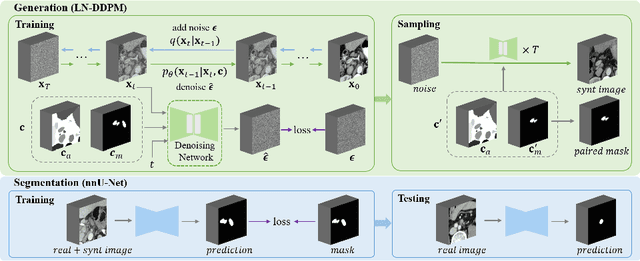

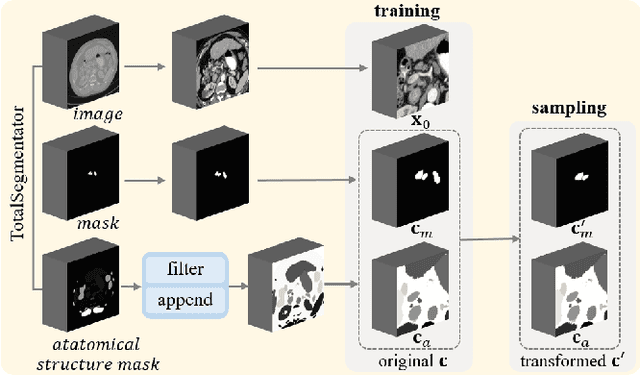
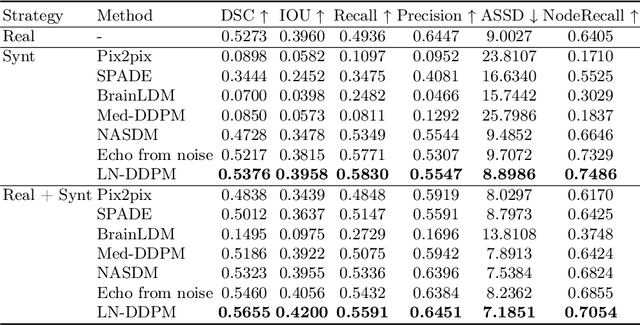
Abstract:Despite the significant success achieved by deep learning methods in medical image segmentation, researchers still struggle in the computer-aided diagnosis of abdominal lymph nodes due to the complex abdominal environment, small and indistinguishable lesions, and limited annotated data. To address these problems, we present a pipeline that integrates the conditional diffusion model for lymph node generation and the nnU-Net model for lymph node segmentation to improve the segmentation performance of abdominal lymph nodes through synthesizing a diversity of realistic abdominal lymph node data. We propose LN-DDPM, a conditional denoising diffusion probabilistic model (DDPM) for lymph node (LN) generation. LN-DDPM utilizes lymph node masks and anatomical structure masks as model conditions. These conditions work in two conditioning mechanisms: global structure conditioning and local detail conditioning, to distinguish between lymph nodes and their surroundings and better capture lymph node characteristics. The obtained paired abdominal lymph node images and masks are used for the downstream segmentation task. Experimental results on the abdominal lymph node datasets demonstrate that LN-DDPM outperforms other generative methods in the abdominal lymph node image synthesis and better assists the downstream abdominal lymph node segmentation task.
Detecting misinformation through Framing Theory: the Frame Element-based Model
Feb 19, 2024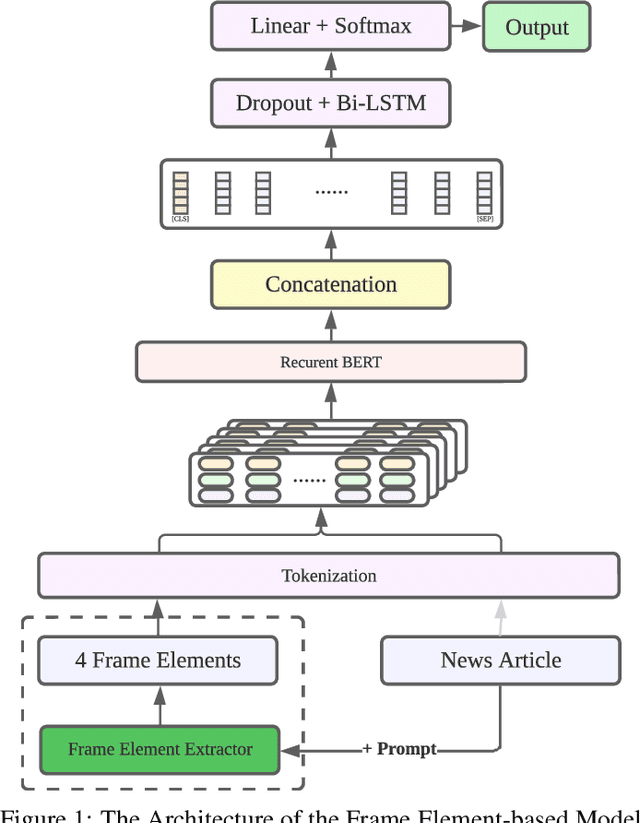
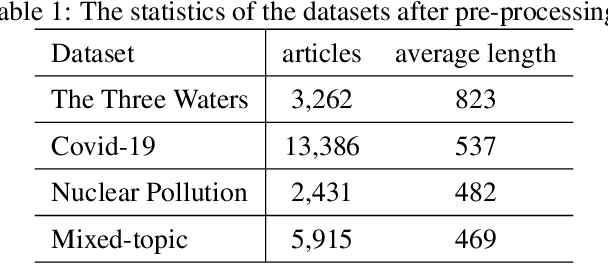
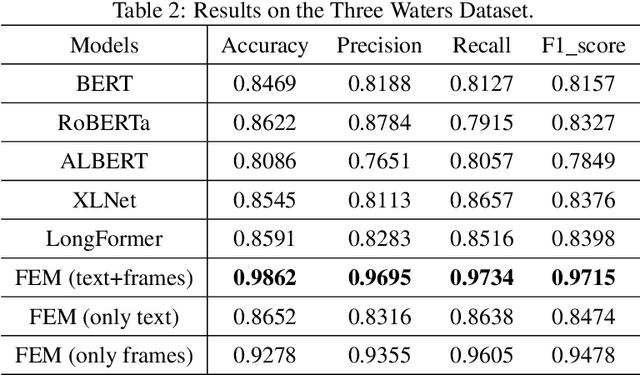
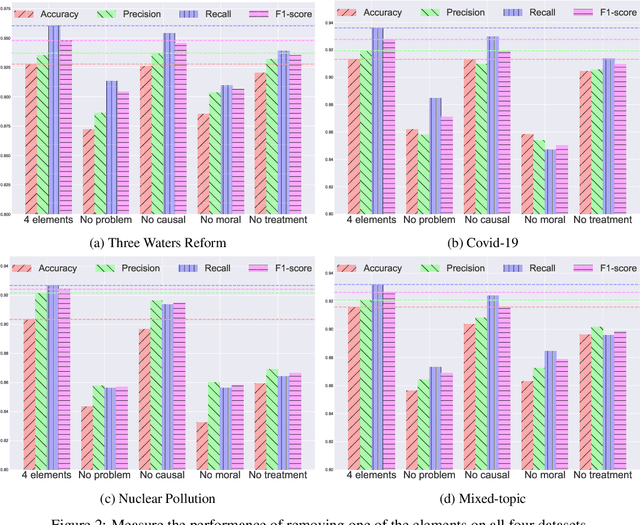
Abstract:In this paper, we delve into the rapidly evolving challenge of misinformation detection, with a specific focus on the nuanced manipulation of narrative frames - an under-explored area within the AI community. The potential for Generative AI models to generate misleading narratives underscores the urgency of this problem. Drawing from communication and framing theories, we posit that the presentation or 'framing' of accurate information can dramatically alter its interpretation, potentially leading to misinformation. We highlight this issue through real-world examples, demonstrating how shifts in narrative frames can transmute fact-based information into misinformation. To tackle this challenge, we propose an innovative approach leveraging the power of pre-trained Large Language Models and deep neural networks to detect misinformation originating from accurate facts portrayed under different frames. These advanced AI techniques offer unprecedented capabilities in identifying complex patterns within unstructured data critical for examining the subtleties of narrative frames. The objective of this paper is to bridge a significant research gap in the AI domain, providing valuable insights and methodologies for tackling framing-induced misinformation, thus contributing to the advancement of responsible and trustworthy AI technologies. Several experiments are intensively conducted and experimental results explicitly demonstrate the various impact of elements of framing theory proving the rationale of applying framing theory to increase the performance in misinformation detection.
Training A Multi-stage Deep Classifier with Feedback Signals
Nov 12, 2023Abstract:Multi-Stage Classifier (MSC) - several classifiers working sequentially in an arranged order and classification decision is partially made at each step - is widely used in industrial applications for various resource limitation reasons. The classifiers of a multi-stage process are usually Neural Network (NN) models trained independently or in their inference order without considering the signals from the latter stages. Aimed at two-stage binary classification process, the most common type of MSC, we propose a novel training framework, named Feedback Training. The classifiers are trained in an order reverse to their actual working order, and the classifier at the later stage is used to guide the training of initial-stage classifier via a sample weighting method. We experimentally show the efficacy of our proposed approach, and its great superiority under the scenario of few-shot training.
 Add to Chrome
Add to Chrome Add to Firefox
Add to Firefox Add to Edge
Add to Edge